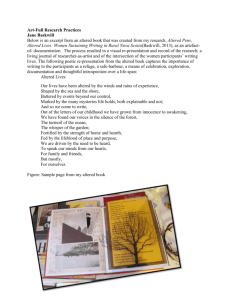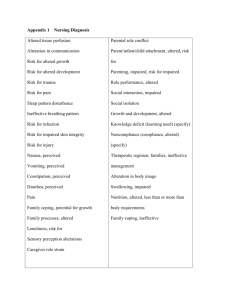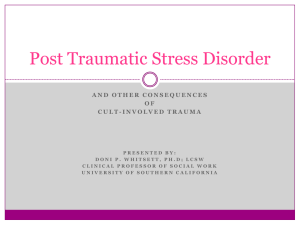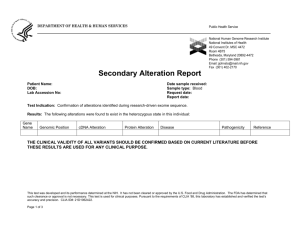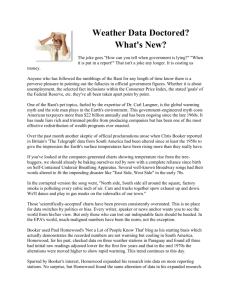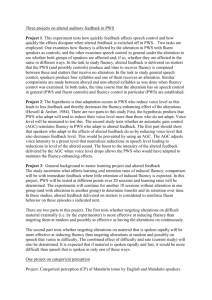4594-F MS-Word - Maine Legislature
advertisement
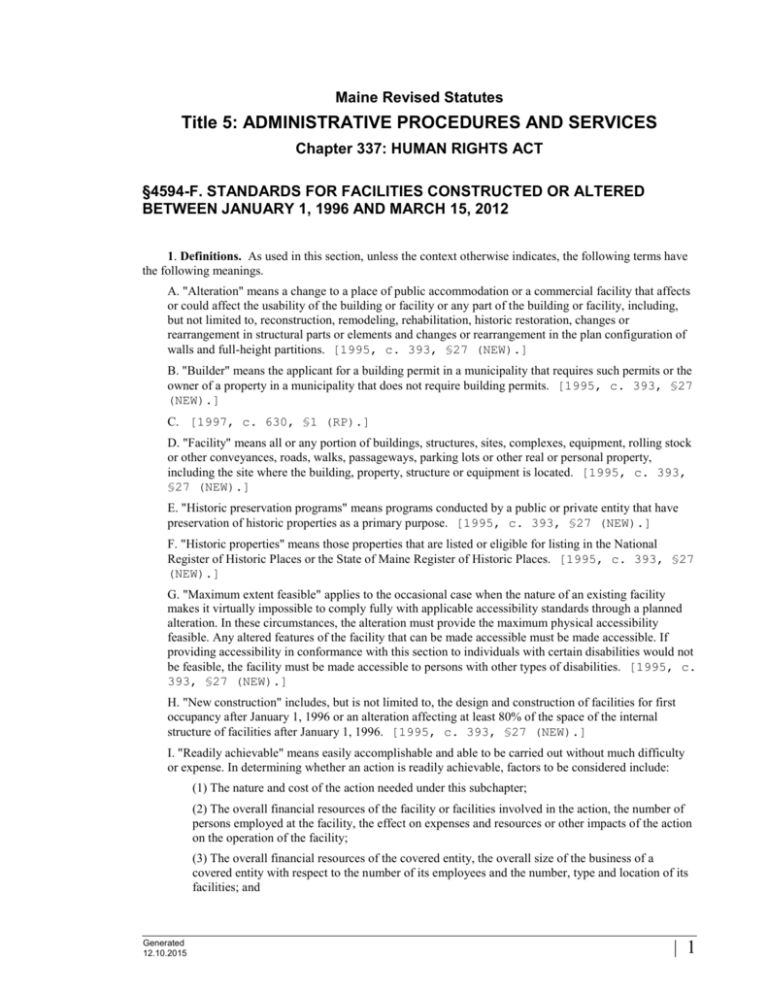
Maine Revised Statutes Title 5: ADMINISTRATIVE PROCEDURES AND SERVICES Chapter 337: HUMAN RIGHTS ACT §4594-F. STANDARDS FOR FACILITIES CONSTRUCTED OR ALTERED BETWEEN JANUARY 1, 1996 AND MARCH 15, 2012 1. Definitions. As used in this section, unless the context otherwise indicates, the following terms have the following meanings. A. "Alteration" means a change to a place of public accommodation or a commercial facility that affects or could affect the usability of the building or facility or any part of the building or facility, including, but not limited to, reconstruction, remodeling, rehabilitation, historic restoration, changes or rearrangement in structural parts or elements and changes or rearrangement in the plan configuration of walls and full-height partitions. [1995, c. 393, §27 (NEW).] B. "Builder" means the applicant for a building permit in a municipality that requires such permits or the owner of a property in a municipality that does not require building permits. [1995, c. 393, §27 (NEW).] C. [1997, c. 630, §1 (RP).] D. "Facility" means all or any portion of buildings, structures, sites, complexes, equipment, rolling stock or other conveyances, roads, walks, passageways, parking lots or other real or personal property, including the site where the building, property, structure or equipment is located. [1995, c. 393, §27 (NEW).] E. "Historic preservation programs" means programs conducted by a public or private entity that have preservation of historic properties as a primary purpose. [1995, c. 393, §27 (NEW).] F. "Historic properties" means those properties that are listed or eligible for listing in the National Register of Historic Places or the State of Maine Register of Historic Places. [1995, c. 393, §27 (NEW).] G. "Maximum extent feasible" applies to the occasional case when the nature of an existing facility makes it virtually impossible to comply fully with applicable accessibility standards through a planned alteration. In these circumstances, the alteration must provide the maximum physical accessibility feasible. Any altered features of the facility that can be made accessible must be made accessible. If providing accessibility in conformance with this section to individuals with certain disabilities would not be feasible, the facility must be made accessible to persons with other types of disabilities. [1995, c. 393, §27 (NEW).] H. "New construction" includes, but is not limited to, the design and construction of facilities for first occupancy after January 1, 1996 or an alteration affecting at least 80% of the space of the internal structure of facilities after January 1, 1996. [1995, c. 393, §27 (NEW).] I. "Readily achievable" means easily accomplishable and able to be carried out without much difficulty or expense. In determining whether an action is readily achievable, factors to be considered include: (1) The nature and cost of the action needed under this subchapter; (2) The overall financial resources of the facility or facilities involved in the action, the number of persons employed at the facility, the effect on expenses and resources or other impacts of the action on the operation of the facility; (3) The overall financial resources of the covered entity, the overall size of the business of a covered entity with respect to the number of its employees and the number, type and location of its facilities; and Generated 12.10.2015 | 1 MRS Title 5 §4594-F. STANDARDS FOR FACILITIES CONSTRUCTED OR ALTERED BETWEEN JANUARY 1, 1996 AND MARCH 15, 2012 (4) The type of operation or operations of the covered entity, including the composition, structure and functions of the entity's work force, the geographic separateness and administrative or fiscal relationship of the facility or facilities in question to the covered entity. [1995, c. 393, §27 (NEW).] J. "Standards of construction" means the standards set forth in the federal Americans with Disabilities Act Accessibility Guidelines, "ADAAG," standards. The ADAAG standards of construction replace ANSI standards and provide the architectural standards of construction. [1995, c. 393, §27 (NEW).] [ 1997, c. 630, §1 (AMD) .] 2. Facilities attested. This section applies to any building or facility constructed specifically as a place of public accommodation or place of employment on or after January 1, 1996 but before March 15, 2012 or to any alterations of an existing place of public accommodation or place of employment when the alteration is begun after January 1, 1996 but before March 15, 2012, unless such construction or alteration is covered by section 4594-G, in which case section 4594-G and not this section applies. As an alternative to compliance with this section, any new construction or alterations covered by this section may comply with section 4594G. [ 2011, c. 322, §7 (AMD) .] 3. Application. Facilities subject to this section must meet the following standards. A. Places of employment or public accommodation and additions to those places constructed on or after January 1, 1996 but before March 15, 2012 must meet the standards of construction, including, but not limited to, the 5 parts of the standards of construction in paragraph B, subparagraph (2). [2011, c. 1, §5 (COR).] B. Alterations are governed by the following. (1) Any alteration to a place of public accommodation, commercial facility or place of employment on or after January 1, 1996 but before March 15, 2012 must be made so as to ensure that, to the maximum extent feasible, the altered portions of the facility are readily accessible to and usable by individuals with disabilities, including individuals who use wheelchairs. If existing elements, spaces or common areas are altered, then each altered element, space or area must comply with the applicable provisions of the standards of construction. (2) This subparagraph applies to only buildings remodeled or renovated or to any alterations if the estimated total costs for remodeling or renovating or for alterations to an existing building exceed $100,000. (a) Except for repairs undertaken in accordance with the rules adopted pursuant to subsection 4, when the proposed alteration substantially affects that portion of the building normally accessible to the public, a place of employment or public accommodation altered on or after January 1, 1996 but before March 15, 2012 must meet the following 5 parts of the standards of construction or as otherwise indicated: (i) 4.3 accessible routes; (ii) 4.13 doors; (iii) Tactile warnings on doors to hazardous areas. Doors that lead to areas that might prove dangerous to a blind person, for example, doors to loading platforms, boiler rooms, stages and the like, must be made identifiable to the touch by a textured surface on the door handle, knob, pull or other operating hardware. This textured surface may be made by knurling or roughening or by a material applied to the contact surface. Textured surfaces may not be provided for emergency exit doors or any doors other than those to hazardous areas; (iv) Parking spaces for use by persons with physical disabilities pursuant to 4.1.2 of the standards of construction; and | 2 Generated 12.10.2015 MRS Title 5 §4594-F. STANDARDS FOR FACILITIES CONSTRUCTED OR ALTERED BETWEEN JANUARY 1, 1996 AND MARCH 15, 2012 (v) 4.17 toilet stalls, at least one of which must be a standard toilet stall configuration pursuant to ADAAG figure 30(a). Any additional toilet stalls within the same toilet room may be either standard stall configuration, ADAAG figure 30(a) or alternate stall configuration ADAAG figure 30(b). (b) In addition to the 5 parts of the standards of construction specified in division (a), each of which must be met regardless of the cost of the 5 parts of the standards, when the entity is undertaking an alteration that affects or could affect usability of or access to an area of the facility containing a primary function, the entity shall also make the alterations in such a manner that, to the maximum extent feasible, the path of travel to the altered area and the bathrooms, telephones and drinking fountains serving the altered area are readily accessible to and usable by individuals with disabilities where such alterations to the path of travel or the bathrooms, telephones and drinking fountains serving the altered area to the extent that the costs to provide an accessible path of travel do not exceed 20% of the cost of the alteration to the primary function area. If the cost to provide an accessible path of travel to the altered area exceeds 20% of the costs of the alteration to the primary function area, the path of travel must be made accessible to the extent that it can be made accessible without incurring disproportionate costs. In determining whether the 20% cost figure has been met, the following analysis must be used. The analysis must include an evaluation of whether the following elements of access have been provided, using the following order of priority, before costing 20%, regardless of other elements of access that may have been provided which may affect the path of travel: (i) An accessible entrance; (ii) An accessible route to the altered area; (iii) At least one accessible restroom for each sex or a single unisex restroom; (iv) Accessible telephones; (v) Accessible drinking fountains; and (vi) When possible, additional accessible elements such as parking, storage and alarms. The obligation to provide an accessible path of travel may not be evaded by performing a series of small alterations to the area served by a single path of travel if those alterations could have been performed as a single undertaking. (3) This subparagraph applies to only buildings remodeled or renovated or to any alterations if the estimated total costs for remodeling or renovating or for alterations to an existing building do not exceed $100,000. When the entity is undertaking an alteration that affects or could affect usability or access to an area of the facility containing a primary function, the entity shall make the alterations in a manner that, to the maximum extent feasible, the path of travel to the altered area and the bathrooms, telephones and drinking fountains serving the altered area are readily accessible to and usable by individuals with disabilities, where the alterations to the path of travel or the bathrooms, telephones and drinking fountains serving the altered area are not disproportionate to the overall alterations in terms of cost and scope. [2011, c. 322, §7 (AMD).] C. This subsection may not be construed to require the installation of an elevator for a facility that is less than 3 stories in height or has less than 3,000 square feet per story unless the facility is a shopping center, a shopping mall, the professional office of a health care provider, a terminal, depot or other station used for specified public transportation or an airport passenger terminal or a facility covered by Title II of the Americans with Disabilities Act or unless the United States Attorney General determines that a particular category of facility requires the installation of elevators based on the usage of the facility. [1995, c. 393, §27 (NEW).] [ 2011, c. 1, §5 (COR) .] 4. Curb ramps. Curb ramps or other slopes are required in the following situations. Generated 12.10.2015 | 3 MRS Title 5 §4594-F. STANDARDS FOR FACILITIES CONSTRUCTED OR ALTERED BETWEEN JANUARY 1, 1996 AND MARCH 15, 2012 A. Newly constructed or altered streets, roads and highways must contain curb ramps or other sloped areas at any intersection having curbs or other barriers to entry from a street-level pedestrian walkway. [1995, c. 393, §27 (NEW).] B. Newly constructed or altered street-level pedestrian walkways must contain curb ramps or other sloped areas at intersections to streets, roads or highways. [1995, c. 393, §27 (NEW).] [ 1995, c. 393, §27 (NEW) .] 5. Rules. The commission shall adopt, alter and amend rules designed to make facilities under this section accessible to, functional for and safe for use by persons with physical or mental disabilities in accordance with subsections 3 and 4 and shall adopt, alter and amend rules designed to enforce this section. The commission may repeal only those rules contrary to this chapter. The commission shall also adopt rules concerning procedures and requirements for alterations that will threaten or destroy the historic significance of qualified historic buildings and facilities as defined in 4.1.7(1) and (2) of the Uniform Federal Accessibility Standards, maintaining, at a minimum, the procedures and requirements established in 4.1.7(1) and (2) of the Uniform Federal Accessibility Standards. [ 1995, c. 393, §27 (NEW) .] 6. Barrier-free certification; inspection. If the costs of construction or alterations are at least $50,000, the builder of a facility to which this section applies must obtain a certification from an architect, professional engineer, certified interior designer or landscape architect who is licensed, certified or registered to practice under Title 32 and is practicing within the scope of that individual's profession that the plans meet the standards of construction required by this section. The builder shall provide the certification to the Office of the State Fire Marshal with the plans of the facility. The builder shall also provide the certification to the municipality where the facility exists or will be built. Nothing in this section may be construed to change the scope of practice of any individual licensed, certified or registered to practice under Title 32. [ 1997, c. 630, §2 (AMD) .] 7. Training, education and assistance. The commission and the Office of the State Fire Marshal, with input from organizations representing individuals with disabilities, shall develop, as necessary, information packets, lectures, seminars and educational forums on barrier-free design for the purpose of increasing the awareness and knowledge of owners, architects, professional engineers, certified interior designers, landscape architects, code enforcers, building contractors, individuals with disabilities and other interested parties. [ 1997, c. 630, §2 (AMD) .] 8. Mandatory plan review; certification; inspection. Builders of newly constructed public buildings shall submit plans to the Office of the State Fire Marshal to ensure that the plans meet the standards of construction required by subsections 3 and 4. A. For purposes of this subsection, "public building" means any building or structure constructed, operated or maintained for use by the general public, including, but not limited to, all buildings or portions of buildings used for: (1) State, municipal or county purposes; (2) Education; (3) Health care; (4) Public assembly; (5) A hotel, motel or inn; (6) A restaurant; (7) Business occupancy; or | 4 Generated 12.10.2015 MRS Title 5 §4594-F. STANDARDS FOR FACILITIES CONSTRUCTED OR ALTERED BETWEEN JANUARY 1, 1996 AND MARCH 15, 2012 (8) Mercantile establishments occupying more than 3000 square feet. [1995, c. 393, §27 (NEW).] B. The municipal authority having jurisdiction to issue building permits may not issue a building permit unless the Office of the State Fire Marshal approves the plans and certifies that the public building covered by this subsection meets the standards of construction required by this section. If no decision is rendered within 2 weeks of submission to the Office of the State Fire Marshal, the builder may submit the building permit request directly to the municipality with an attestation from an architect or professional engineer licensed or registered to practice under Title 32 that the plans meet the standards of construction. [1997, c. 630, §3 (AMD).] C. If officials of the municipality in which a restaurant; motel; hotel; inn; state; municipal or county building; or an elementary or secondary school covered by this subsection is constructed, renovated, remodeled or enlarged inspect buildings for compliance with construction standards, that inspection must include an inspection for compliance with the certified plans. The municipal officials shall require that a facility covered by this paragraph be inspected for compliance with construction standards before the municipal officials permit a facility covered by this paragraph to be occupied. [1995, c. 393, §27 (NEW).] [ 1997, c. 630, §3 (AMD) .] 9. Voluntary plan review. Builders of facilities not governed by subsection 8 may submit plans to the Office of the State Fire Marshal to ensure that the plans meet the standards of construction required by subsections 3 and 4. Certification for a voluntary plan review may be provided by an architect, professional engineer, certified interior designer or landscape architect licensed, certified or registered to practice under Title 32 and practicing within the scope of that individual's profession. [ 1997, c. 630, §4 (AMD) .] 10. Waivers; variance. Builders of facilities governed by subsection 8 that are private entities, when the facilities are not to be owned or operated by, or leased to or by, a public entity, may file a petition with the State Fire Marshal requesting a waiver or variance of the standards of construction. If a representative of the Office of the State Fire Marshal determines, in cases covered by mandatory plan review pursuant to subsection 8, that compliance with this section and its rules is structurally impracticable, the State Fire Marshal may provide for modification of, or substitution for, these standards. In all petitions for variance or waiver, the burden of proof is on the party requesting the variance or waiver to justify its allowance. [ 1995, c. 393, §27 (NEW) .] 11. Appeals relating to mandatory plan reviews. Decisions of the State Fire Marshal on requests for waivers or variances in cases covered by mandatory plan review under subsection 8 are subject to review in Superior Court upon petition of the aggrieved party within 30 days after the issuance of the decision for which review is sought. The court may enter an order enforcing, modifying or setting aside the decision of the State Fire Marshal, or it may remand the proceeding to the State Fire Marshal for further action as the court may direct. [ 1995, c. 393, §27 (NEW) .] 12. Fees. The Office of the State Fire Marshal shall establish fees for reviews, waivers or variances under this section. The Office of the State Fire Marshal shall pay all fees to the Treasurer of State to be used to carry out this chapter. Any balance of these fees does not lapse but is carried forward as a continuing account to be expended for the same purposes in the following fiscal years. [ 1995, c. 393, §27 (NEW) .] SECTION HISTORY 1995, c. 393, §27 (NEW). 1997, c. 630, §§1-4 (AMD). (COR). 2011, c. 322, §7 (AMD). Generated 12.10.2015 RR 2011, c. 1, §5 | 5 MRS Title 5 §4594-F. STANDARDS FOR FACILITIES CONSTRUCTED OR ALTERED BETWEEN JANUARY 1, 1996 AND MARCH 15, 2012 The State of Maine claims a copyright in its codified statutes. If you intend to republish this material, we require that you include the following disclaimer in your publication: All copyrights and other rights to statutory text are reserved by the State of Maine. The text included in this publication reflects changes made through the First Regular Session of the 127th Maine Legislature and is current through October 15, 2015. The text is subject to change without notice. It is a version that has not been officially certified by the Secretary of State. Refer to the Maine Revised Statutes Annotated and supplements for certified text. The Office of the Revisor of Statutes also requests that you send us one copy of any statutory publication you may produce. Our goal is not to restrict publishing activity, but to keep track of who is publishing what, to identify any needless duplication and to preserve the State's copyright rights. PLEASE NOTE: The Revisor's Office cannot perform research for or provide legal advice or interpretation of Maine law to the public. If you need legal assistance, please contact a qualified attorney. | 6 Generated 12.10.2015
